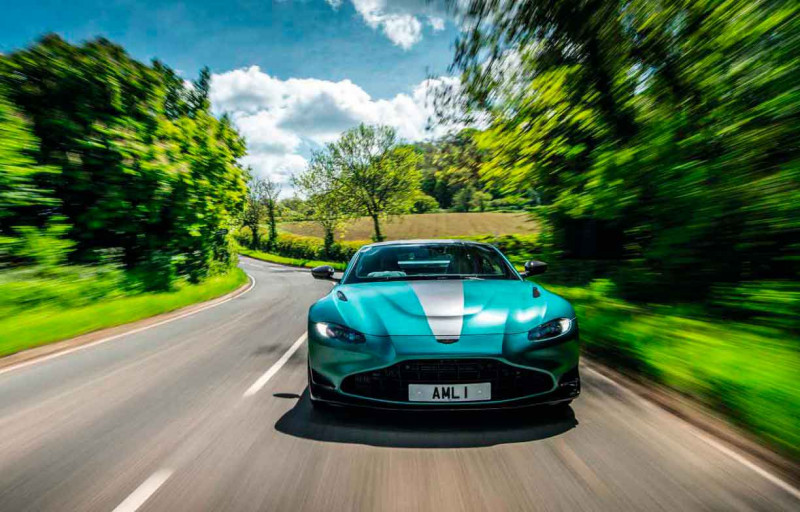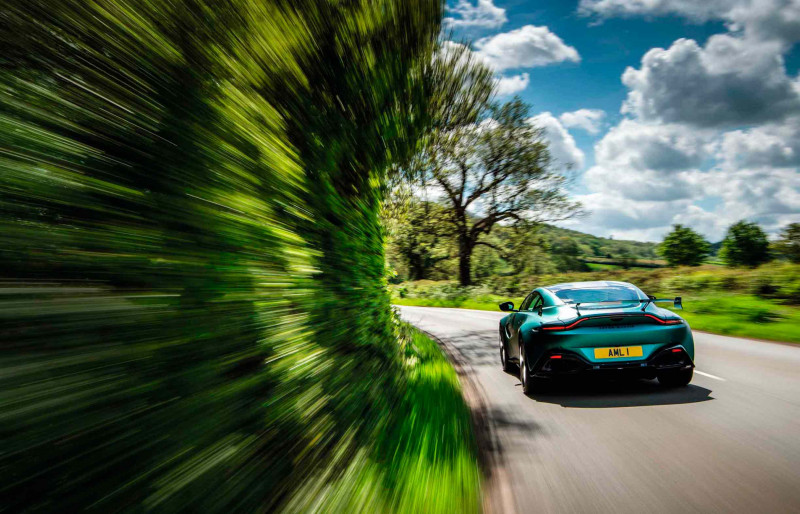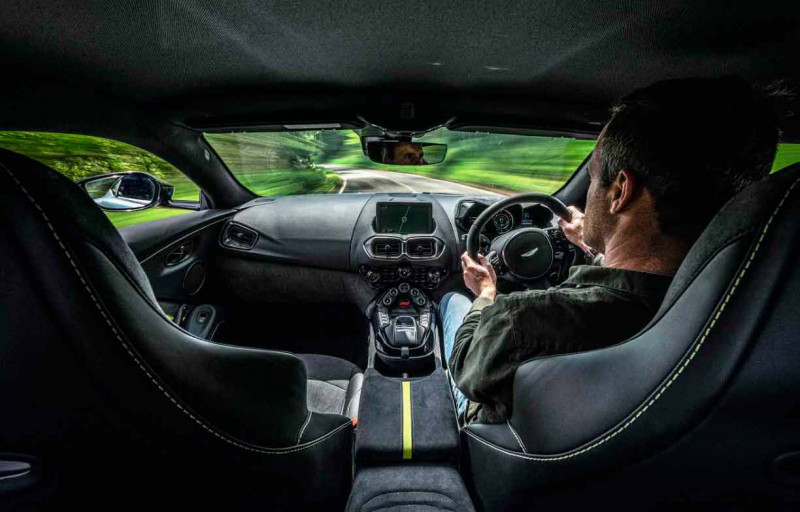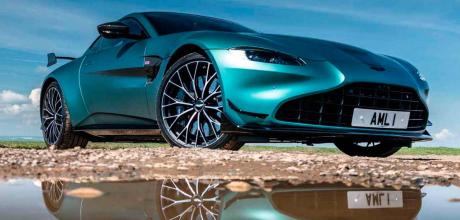2022 Aston Martin Vantage F1 Edition
With more power, more grip and more control, this new special edition is the best current-generation Vantage yet.
FIRST DRIVES
This month: Aston Martin’s Vantage F1 Edition
Hope, I’m not sold on the wing. Or the wheel design, and neither The mix of gloss carbon, satin paint and matt stripes, or those modish diamond cut wheels. Oops, did I say that out loud? Sorry. Unintentional. These things are entirely subjective, of course. You may feel differently, and you’re entirely free to do so. But ‘F1 Edition’ – really? The obvious conclusion is that this is a special edition timed to coincide with Seb and Lance’s weekend wheels turning green. As manufacturers struggle to shift expensive new high-performance cars, every opportunity has to be capitalised upon to shift more metal.

Actually, while your cynicism might point you in that direction, the above really is not the case; I can only encourage you to read on, because this is one special edition that definitely needs to be glowing angrily on your radar.
‘It’s easily the best Vantage I’ve driven, probably the most sorted Aston in years’
The F1 Edition has its basis in the work Aston Martin has undertaken to create the 2021 Safety and Medical cars for F1. The latter is a conscientiously developed DBX, the former a Vantage with both higher performance and endurance for what is a very demanding role once you get into the nitty gritty of the mission statement. We’ll be talking more about those cars in a future issue, but off the back of them comes the F1 Edition road car, which according to Aston’s head of performance, Matt Becker, is much more than just a ‘wings and stripes’ job; rather it is an attempt to push the performance of the Vantage without going so far as to exchange war paint with a 911 GT3. Aston boss Tobias Moers wants the company to launch more model derivatives, to give customers more choice, and to create a hierarchy for buyers to aim for in the longer term. And I wouldn’t mind betting that there’s also tacit acknowledgement that the company’s recent model blitz resulted in cars like the DB11 and Vantage being positioned too closely together, neither one successfully dominating the GT sector or taking the sports car fight to the likes of Porsche’s 911 992and Audi’s R8. The F1 Edition is a chance to give the Vantage a sharper set of claws.

When Becker tells you that the base of the steering column has been pinned to remove a vestigial amount of compliance that was originally engineered into it, you know this is going to be an interesting car. The thinking during the Vantage’s development back in the middle of the previous decade was that a GT car didn’t necessarily need to inform you about the road’s
surface all the time. But a genuine sports car should, and so it has gone. The front spring rate is the same as before, but the bump stops are stiffer for more support, while there’s also been a 30 per cent increase in the low-speed rebound damping. Chasing that crucial steering precision has also led to the front shear panel – effectively a tray underneath the suspension that also has the effect of tying everything together – doubling in thickness.

At the rear, the spring rate is up 10 per cent and the compression damping by 20, while the bushing on the upper control arms is 20 percent stiffer. The goal was to vertically support the car more, and to improve the tyre’s contact patch with the ground. Talking of which, the F1 runs on Pirelli P Zeros in a 21-inch diameter for the first time; Moers was keen to avoid fitting a track-focused tyre but at the same time was looking for a significant drop in the car’s Ring lap time. Paying such close attention to empirical measurement at that cathedral of faszination has usually been an anathema to Aston Martin, but the times they are a-changin’ and Becker’s team has responded in kind. Modifying the P Zero’s compound led to them overheating, but the reduced sidewall of the 21-inch size led to an increase in lateral stiffness that brought an improvement without a compound change. The overall grip increase is small, but the plateau of available grip and the subsequent drop off is much broader, in the wet or dry, than the smaller rubber. The lap time now stands around 7min 30sec, in case you were wondering – a 15-second improvement over what the standard Vantage can achieve.
Say what you like about the new rear wing, but the combination of it and a new front splitter, dive planes and underbody additions mean that the Vantage has gone from a car that at its maximum velocity produces a small amount of front lift and 40kg of downforce at the rear, to one that has 60kg of downforce over the front axle and 150kg at the rear. Sure, you’re not likely to feel the full force of that very oen as an owner, but the increase in stability should be noticeable at lower velocities and it’s nice to know the F1’s looks aren’t just for show.
The final change for your extra £17,600 outlay over a regular Vantage – the F1 Edition starts at £142,000 – is a small tickle for the powertrain, with peak power rising a nominal amount from 503 to 527bhp. Torque remains the same at 505lb ft, but this peak is held for longer with a view to making the engine more drivable, even if Aston’s official acceleration and top speed figures are unchanged at 3.6sec and 195mph. And that ZF eight-speed auto ZF 8HP24 (there’s no seven-speed manual option for the F1 Edition, but given our views on the quality of that shift
perhaps on this occasion it’s not the end of the world) has had some subtle development, too, because the aforementioned big boss felt the engineered-in jolts between ratios in the more aggressive settings were a bit passé, and that drivers would prefer a clean shift that was as fast as those Wellesbourne-based engineers could make it, like they do at Weissach. They’ve also included some clever soware that means the ’box is much less likely to refuse a downshift when braking hard from speed, as it can now foresee that revs and wheel speed will match by the time the action is implemented – particularly beneficial during track driving.
So as you can see, the F1 Edition is far from a light makeover, and, frankly, even if I wasn’t aware of all of the above, it would still be patently obvious that it was a thorough job, because this feels like a fundamentally different and far more appealing Vantage even in the first 50 yards. Sure, all the things that have always been loveable about this car are present, from the low-slung driving position to the sinister snarl of the V8 and its instant pick-up. But you only need to nudge the steering wheel left or right to sense a calmness and fluidity to the way it responds that simply isn’t there in the standard car. The modifications may sound as though they’ve made this amore demanding machine along with amore involving and ultimately rewarding one, but just as the ride quality of the F1 Edition is far from compromised – I think I actually prefer its accurate and direct composure when dealing with surface irregularities – so the precision of its steering makes it an easier car to drive at all speeds. Becker was chasing linearity of response and he and his team have succeeded admirably: it’s an easier car to place on the road than the standard Vantage, and one that begs to be positioned down to the last millimetre, almost goading you to up your own game as you drive.
Suddenly the Vantage doesn’t seem so wide and intimidating, the effects of sitting low in its bathtub-esque cabin negated by the driver’s increased confidence. The Warwickshire lanes close to Aston’s HQ are narrow but I’m rarely giving it a second thought, instead wishing they continued threefold so I could really get in a groove, relishing the way you can thread the car along such roads with a real sense of purpose.
The second really obvious difference to before is how little seems to be going on at the rear axle. Becker admits the standard car can get a little busy when attempting to deploy all that V8 grunt on uneven surfaces, but instantly I notice how the rear suspension no longer seems to be locked in a push-me-pull-me tussle with the torque being transmitted via the rear driveshafts. Again, it’s just so much more confidence inspiring because rather than the battle forcing its way to the front of your mind, you’re now free to listen to the subtler messages about grip and impending slip that the car is trying to tell you.
In the dry the F1 Edition has surprisingly strong traction, despite its turbo-fed V8 and traditional front-engine, rear-wheel-drive layout, but when the limit of grip is exceeded it feels natural to let the rear overspeed slightly on the edge of a slide. I find myself driving with the ESP safety net off just on the off-chance a hooligan moment suddenly materialises – again, not something I’d have been particularly inclined to bother with before. Another small tweak that’s helped in this regard is the adoption of an additional damper between the gearbox mount and the car. The team tried harder mounts but found the subsequent deterioration in NVH unacceptable in a car that’s supposed to retain most of its GT credentials, but the damper helps to soak up the momentum of the transaxle in rapid direction changes, and there’s no denying the newfound composure at the rear.
There’s also a greater sense of sophistication to the powertrain as well, which doesn’t feel radically different from before, naturally, but just feels like the standard car after a high-protein shake and successful morning bowel movement. It’s peppy, fluid and energetic, as well as doing all the rumbly, low-down torquey stuff you’d expect, and the new shift strategy is a masterstroke because it adds a lovely layer of gloss to the powertrain. A torque converter can’t match a twin-clutch transmission for ultimate speed and that sense of precision we all crave, but just as with the steering, I no longer find myself questioning its attributes because it feels authentic, and the realisation that I'm constantly driving it on the paddles rather than letting the 'box sort it out itself is a further reflection that this is a Vantage that wants to be driven with spirit and enthusiasm.
It's still a car with that weighty, almost British muscle car feel to how it goes about its business, but then that's no bad thing — the Vantage has always been its own character, as distinct from a Porsche, a McLaren or even something like a Bentley Continental GT as it's possible to be, yet within the same sphere of attractive coupes with major league performance. Yet for me, this car is a game changer for Aston Martin. Regular readers will be aware that our history with the current Vantage is patchy: the early cars we drove simply weren't up to scratch, either through design and/or poor set-up on the day, and while later examples drove much better (and would have fared a lot better in that initial group test where the Vantage slumped to a minor position), it's a car that has continued to split opinion within our editorial team. I think it's fair to say editor
Gallagher fell for the example he ran on our Fast Fleet last year, whereas I admired it, but didn't covet it, enjoyed the idea of it more than the actual driving of it. The F1 Edition changes all that. It's easily the best Vantage I've driven, probably the most sorted Aston Martin I've driven in years, and if this is a sign of where the company is going with its cars then the future deserves to be very bright indeed. You can order one with either a coupe or roadster body, and it also comes in other colours, too. I feel an eCoty entry on the cards...
- Engine V8, 3982cc, twin-turbo
- Max Power 527bhp @ 6000rpm
- Max Torque 505lb ft @ 2000-5000rpm
- Weight (dry) 1530kg (350bhp/ton)
- 0-62mph 3.6sec
- Top speed 195mph
- Basic price £142,000
- + Brilliantly hones the Vantage recipe
- — Looks won’t be for everyone
- Drive rating 5/5
Left: Racing Green, Jet Black and Lunar White are the colour options, each available with a gloss or satin finish. Below left: twin-turbocharged V8 gains 24bhp
Above left: new rear wing contributes to a significant increase in downforce. Far left: wheels are 21-inch items for the first time; brake discs remain cast-iron.
Above: F1 Edition gets unique interior trim, combining black leather with grey Alcantara, plus stripes and stitching in a choice of lime green, black, grey or red.
‘It feels like a fundamentally different Vantage in the first 50 yards’


